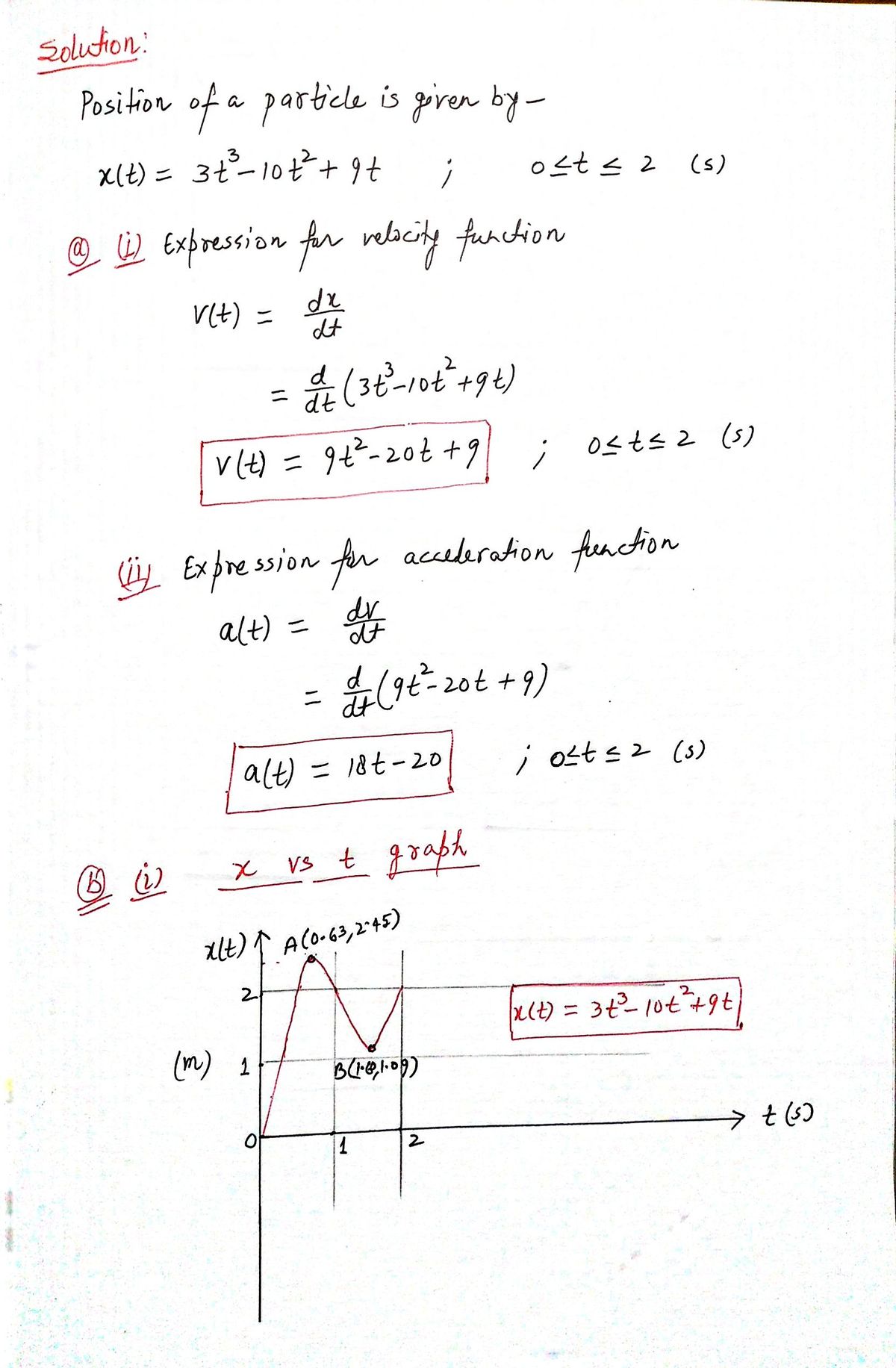c) At what time(s), if any, is the particle instantaneously at rest? Comment on how your result relates to your graphs in part (b). d) At what time(s), if any, is the particle's velocity instantaneously not changing? Comment on how your result relates to your graphs in part (b). e) Find the greatest position value (farthest point from the origin) reached by the particle during this time period. Comment on how your result relates to your graphs in part (b). f) At what time is the particle speeding up at the greatest rate? Explain. g) At what time is the particle slowing down at the greatest rate? Explain.
c) At what time(s), if any, is the particle instantaneously at rest? Comment on how your result relates to your graphs in part (b). d) At what time(s), if any, is the particle's velocity instantaneously not changing? Comment on how your result relates to your graphs in part (b). e) Find the greatest position value (farthest point from the origin) reached by the particle during this time period. Comment on how your result relates to your graphs in part (b). f) At what time is the particle speeding up at the greatest rate? Explain. g) At what time is the particle slowing down at the greatest rate? Explain.
College Physics
11th Edition
ISBN:9781305952300
Author:Raymond A. Serway, Chris Vuille
Publisher:Raymond A. Serway, Chris Vuille
Chapter1: Units, Trigonometry. And Vectors
Section: Chapter Questions
Problem 1CQ: Estimate the order of magnitude of the length, in meters, of each of the following; (a) a mouse, (b)...
Related questions
Concept explainers
Topic Video
Question
Please show work

Transcribed Image Text:2. The position of a particle between t = 0 and t = 2.00s is given by a(t) = (3.00 m/s³)³-(10.0 m/s²)t² + (9.00 m/s)t.
a) Find expressions for
(i) the particle's velocity as a function of time (v (t)), and
(ii) the particle's acceleration as a function of time (a (t)).
b) Sketch
(i) an a vs. t graph for this particle,
(ii) a v vs. t graph for this particle,
(iii) an a, vs. t graph for this particle.
(For this part, you may use a graphing calculator or computer; curve-sketching techniques you may have
learned in math can also be helpful, and will be illuminating when answering some of the later parts of the
question.)
CONTINUED ON NEXT PAGE

Transcribed Image Text:c) At what time(s), if any, is the particle instantaneously at rest? Comment on how your result relates to
your graphs in part (b).
d) At what time(s), if any, is the particle's velocity instantaneously not changing? Comment on how your
result relates to your graphs in part (b).
e) Find the greatest position value (farthest point from the origin) reached by the particle during this time
period. Comment on how your result relates to your graphs in part (b).
f) At what time is the particle speeding up at the greatest rate? Explain.
g) At what time is the particle slowing down at the greatest rate? Explain.
Expert Solution
Step 1

Step by step
Solved in 4 steps with 4 images

Knowledge Booster
Learn more about
Need a deep-dive on the concept behind this application? Look no further. Learn more about this topic, physics and related others by exploring similar questions and additional content below.Recommended textbooks for you

College Physics
Physics
ISBN:
9781305952300
Author:
Raymond A. Serway, Chris Vuille
Publisher:
Cengage Learning

University Physics (14th Edition)
Physics
ISBN:
9780133969290
Author:
Hugh D. Young, Roger A. Freedman
Publisher:
PEARSON

Introduction To Quantum Mechanics
Physics
ISBN:
9781107189638
Author:
Griffiths, David J., Schroeter, Darrell F.
Publisher:
Cambridge University Press

College Physics
Physics
ISBN:
9781305952300
Author:
Raymond A. Serway, Chris Vuille
Publisher:
Cengage Learning

University Physics (14th Edition)
Physics
ISBN:
9780133969290
Author:
Hugh D. Young, Roger A. Freedman
Publisher:
PEARSON

Introduction To Quantum Mechanics
Physics
ISBN:
9781107189638
Author:
Griffiths, David J., Schroeter, Darrell F.
Publisher:
Cambridge University Press

Physics for Scientists and Engineers
Physics
ISBN:
9781337553278
Author:
Raymond A. Serway, John W. Jewett
Publisher:
Cengage Learning

Lecture- Tutorials for Introductory Astronomy
Physics
ISBN:
9780321820464
Author:
Edward E. Prather, Tim P. Slater, Jeff P. Adams, Gina Brissenden
Publisher:
Addison-Wesley

College Physics: A Strategic Approach (4th Editio…
Physics
ISBN:
9780134609034
Author:
Randall D. Knight (Professor Emeritus), Brian Jones, Stuart Field
Publisher:
PEARSON